|
|
|
Sort Order |
|
|
|
Items / Page
|
|
|
|
|
|
|
| Srl | Item |
| 1 |
ID:
146883
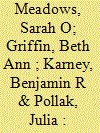

|
|
|
|
|
| Summary/Abstract |
Drawing upon data from the Deployment Life Study, this article examines whether female military spouses (SPs) are disadvantaged relative to matched civilian peers in terms of hours worked and earnings, paying particular attention to gaps among the highest educated women. Female SPs do earn less than comparable civilian peers in terms of raw dollars and percentage earnings. Moreover, military wives who are part of the labor force work as many hours as their civilian counterparts, but still earn significantly less for that work. Contrary to predictions, the most educated SPs are not disproportionately affected compared to spouses with less education. These results suggest that SPs at all education levels could benefit from employment assistance; in particular, women already participating in the labor force may benefit from support in finding higher paying jobs.
|
|
|
|
|
|
|
|
|
|
|
|
|
|
|
|
| 2 |
ID:
157679


|
|
|
|
|
| Summary/Abstract |
Pioneering feminist International Relations scholarship suggests that in order to function, militaries rely on spouses, most often wives, to undertake the majority of domestic labour, suspend their own careers, and relocate willingly for new postings. However, the contemporary military family’s relationship to war making may be different because family forms are changing: norms around domestic responsibilities and primary earners suggest greater gender equality, and women are contributing to war making as soldiers. Thus, this paper asks whether the military’s reliance on the traditional family, and conventional gender relations, is being reinforced or destabilized by policies and programs that speak to Canadian military families. A critical feminist policy analysis of select policy and program documents, which address unique and characteristics of military life (mobility and separation) is undertaken. While there is discursive acknowledgment of the changing composition of military families, traditional familial and gendered assumptions persist in subtle ways.
|
|
|
|
|
|
|
|
|
|
|
|
|
|
|
|
| 3 |
ID:
186076
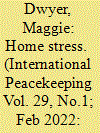

|
|
|
|
|
| Summary/Abstract |
Through the case of the Sierra Leonean deployment on the African Union Mission in Somalia (AMISOM), this study argues that family-related stress is an often-overlooked challenge in peacekeeping deployments. Using in-depth interviews with Sierra Leonean soldiers who were part of the deployment, military decision makers, and foreign advisors, this article lays out specific factors that created family-related tensions and contributed to lowered morale for Sierra Leonean peacekeepers. It demonstrates that the family-related stress on deployment is not only an issue of family separation, it is entangled with the historic trajectories of the armed forces and the sending country’s socio-economic conditions. The focus on Sierra Leone highlights the additional and unique burdens that soldiers and their families may endure in troop contributions from lower-income countries.
|
|
|
|
|
|
|
|
|
|
|
|
|
|
|
|
| 4 |
ID:
193055
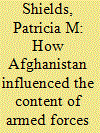

|
|
|
|
|
| Summary/Abstract |
This commentary examines the influence of the Afghanistan war on the content of Armed Forces & Society. My 20-year tenure as editor of Armed Forces & Society overlaps completely with the war. Using the lenses of the postmodern or post-Cold War military, I reflect on how the articles of this journal were influenced by the war. The postmodern military relies more heavily on volunteers, is more likely to engage in unconventional missions, and more likely to use multinational forces. I found an increase in articles devoted to reserve forces and contractors. In addition, many articles investigated the unique management challenges of the International Security Assistance Force (ISAF). The multiple deployments and brutal nature of the war led to a large increase in health/mental health articles and also contributed to changes in the scope of the military family and veterans’ literature. The limited civil–military relations literature was affected indirectly.
|
|
|
|
|
|
|
|
|
|
|
|
|
|
|
|
| 5 |
ID:
101324
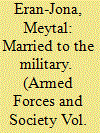

|
|
|
|
|
| Publication |
2011.
|
| Summary/Abstract |
Twenty years after the last research was conducted on military families in the Israel Defense Forces (IDF), this study explores gender arrangements in families of male and female career military personnel as viewed by their civilian spouses. The research objective was to analyze the differences in attitudes toward family life and examine the differences in work-family practices among the IDF's career servicemen and women. The findings indicate that the IDF's heavy demands on career personnel, regardless of gender lead to the construction of family and couple arrangements that deviate from the norm in civilian Israeli-Jewish families of similar characteristics. For the servicemen, this demand creates a ''traditional'' role division model that places the entire burden of family work on their wives; for the servicewomen the same demands create a relatively ''egalitarian'' role division model, by placing more of the burden of ''family chores'' on their husbands.
|
|
|
|
|
|
|
|
|
|
|
|
|
|
|
|
| 6 |
ID:
117621
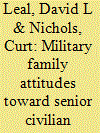

|
|
|
|
|
| Publication |
2013.
|
| Summary/Abstract |
This article examines Army spousal attitudes toward senior civilian leaders in the United States. Based on the 2004 Military Families Survey, it investigates the demographic, political, and institutional factors that structured the job approval ratings of then-President George W. Bush, Secretary of Defense Donald Rumsfeld, and Secretary of State Colin Powell. Partisanship, race and ethnicity, and opinions about the war in Iraq were consistently significant predictors; experiences directly related to the Iraq war were not. For instance, while Republicans and Latinos were highly likely to support the leadership, past and present deployments were not significant. In addition, Army spouses appear to have distinguished between the three leaders. The results have implications for researchers interested not only in military families but also the role of race and ethnicity in the armed forces, retention dynamics, the civil-military gap, and the Army in a time of war.
|
|
|
|
|
|
|
|
|
|
|
|
|
|
|
|
| 7 |
ID:
085368
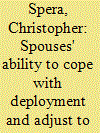

|
|
|
|
|
| Publication |
2009.
|
| Summary/Abstract |
Using data from 34,381 Air Force active-duty members, the current study examines active-duty members' perceptions of their spouse's or significant other's ability to cope with deployment of unknown length and adjust to demands of being an Air Force family. Active-duty members' perception of their spouse's ability to cope with deployment significantly varied by rank and time married, with 35 percent of junior enlisted and 30 percent of members married less than three years indicating their spouse would have a serious or very serious problem coping with deployment of unknown length. Protective factors-unit relationship quality, leadership effectiveness, and tangible social support from community members-were positively and significantly related to members' reports of spousal ability to adjust to Air Force family demands. The variance explained by these protective factors was highest for active-duty members who had been away from home for deployment or temporary duty for more than six months in the past twelve months.
|
|
|
|
|
|
|
|
|
|
|
|
|
|
|
|
| 8 |
ID:
091690
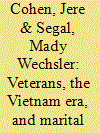

|
|
|
|
|
|
|
|